La Bestia
The Politics and Poetics of Infrastructure
Summer 2018
“The Beast” is the nickname of a cargo train network that connects the southern and northern borders of Mexico, making it an important infrastructure system for the economy of the country because of the national and international exchange of material goods. In addition to fulfilling its official use of transporting products, this infrastructure of movement is also loaded with a heavy social and political meaning, it is used by almost 150,000 migrants a year —primarily from El Salvador, Honduras and Guatemala— as an informal alternative of transportation to reach the Mexican border with the United States of America. Starting in the southern Mexican border, immigrants from the Northern Triangle and other countries from South America, try to escape from their vulnerable social and political situation looking for a better life, following the so called “American Dream”.
As Brian Larkin states in “The Politics and Poetics of Infrastructure”, infrastructures are built networks that facilitate the flow of goods, people, or ideas and allow for their exchange over space [01] , but they also have other meanings among societies, different from its “purely technical functioning” and related to the concrete issue of form and its political and cultural meanings, called “the poetics of infrastructure” (Larkin, 2013).
In the collective imaginary, this train system is known as “La Bestia” (The Beast), responding to people’s perception of it as invasive and threatening entity, an object of great dimensions, that moves at high speeds and harms everything that’s on its way. This poetic [02] vision, from both permanent residents and migrants, about “The Beast” is, on the side of the residents, due to the violent way in which it crosses and divides the human settlements, acting as a physical and auditory barrier in the towns and cities, also, it is seen with a negative connotation due to the amount of immigrants that arrive with the train, often perceived as a threat by the residents. The second meaning is that given by migrant citizens, the temporary residents of the train, who relate this nickname directly to the injuries and deaths caused by traveling on it, due to its high transit speed and the dangers they face when using this infrastructure in an unorthodox way.
In this journey, these “urban migrants” [03] traverse a series of temporary settlements. Starting from the train, in which they live and travel for almost a month, the network of established shelters in which they spend some nights of the 30 days of travel and the ephemeral settlements they’ve stablished in some abandoned urban infrastructures to wait for the next trains. As a result of a forced migration, this long and risky travel is seen by immigrants as the mean to change from the temporary to the permanent, it’s believed to be a path towards the future of social and economic stability they’ve been looking for.
According to Agamber, “The camp is the space that opens up when the state of exception starts to become the rule” [03], if we understand how every law is suspended along all these kilometers and how invisible this immigrants become when they are ignored by the state, we can see “La Bestia” as a moving camp, the infra-structure in which people loose an “official identitiy” and escape from a fractured society to get into another one, an urban typology that “belongs nonetheless to the past, but rather in some sense as the hidden matrix and nomos of the political space in which the still live” [04].
As moving camp, as an infrastructural system heavy on political meanings, and creating a resulting network of solidarity on its way, “La Bestia” crosses the Mexican territory acting as a symbol of hope and as a threat at the same time, affecting every settlement in which it passes trough, from rural communities to industrial cities. This project studies the consequences and effects this infrastructure of mobility causes in its way when its used by its second and less acknowledged meaning, accompanied by a detailed journey of the immigrants that travel on it.

Global Flows

Mexico has a rail network of more than 26 thousand kilometers, operated by private sector concessionaires. This same network is used by migrant persons to traverse the territory. A network of more than 100 shelters for migrant persons expands through the country following the railroad lines.

Migrants traverse many natural regions and heights along their journey, exposed day and night above the wagons.

The train causes different impacts in rural towns and cities.




